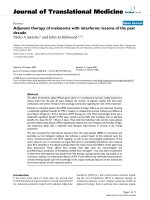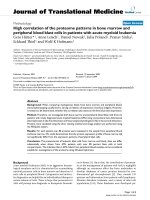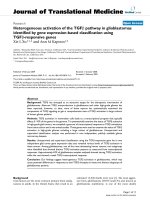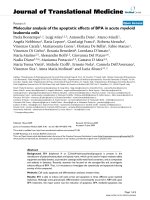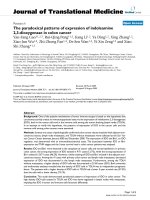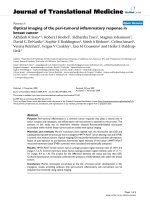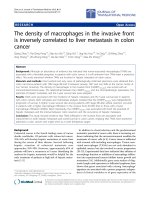báo cáo hóa học: " The responsiveness of the uterine fibroid symptom and health-related quality of life questionnaire (UFS-QOL)" doc
Bạn đang xem bản rút gọn của tài liệu. Xem và tải ngay bản đầy đủ của tài liệu tại đây (216.58 KB, 8 trang )
BioMed Central
Page 1 of 8
(page number not for citation purposes)
Health and Quality of Life Outcomes
Open Access
Research
The responsiveness of the uterine fibroid symptom and
health-related quality of life questionnaire (UFS-QOL)
Gale Harding*
†1
, Karin S Coyne
†1
, Christine L Thompson
†1
and
James B Spies
†2
Address:
1
United BioSource Corporation, 7101 Wisconsin Ave, Suite 600, Bethesda, MD 20814, USA and
2
Georgetown University Dept. of
Radiology, Room CG201, Bldg. CC, 3800 Reservoir Rd, NW, Washington, DC 20007-2197, USA
Email: Gale Harding* - ; Karin S Coyne - ;
Christine L Thompson - ; James B Spies -
* Corresponding author †Equal contributors
Abstract
Background: A number of noninvasive alternatives to hysterectomy have become available as
treatments for uterine fibroids. These alternative therapies, however, may not relieve all
symptoms. Consequently, the need for patient-reported outcomes to assess symptom reduction
of uterine fibroids has become increasingly important to evaluate the clinical success of patients
who choose these alternative therapies. The purpose of the study was to examine the
responsiveness of the Uterine Fibroid Symptom and Health-Related Quality of Life Questionnaire
(UFS-QOL) with treatment of uterine fibroids.
Methods: The responsiveness of the UFS-QOL was assessed as a post-hoc analysis of patients
treated with MRI-guided focused ultrasound thermal ablation (MRgFUS) for uterine fibroids. The
UFS-QOL and SF-36 were completed at baseline and months 1, 3, and 6. Patient perceived overall
treatment effect (OTE) was assessed at month 3, while satisfaction with treatment was collected
at month 6. The responsiveness of the UFS-QOL was examined using effect sizes and change scores
by patient-reported overall treatment effect and satisfaction.
Results: A total of 102 women with complete UFS-QOL data were included in the analysis; the
mean age was 45 years and 79% were Caucasian. From baseline to 6 months, significant
improvements were observed in UFS-QOL Symptom Severity and all Health-Related Quality of Life
(HRQL) subscale scores (p < 0.0001). When examining change in general health status over the 6-
month follow-up period, significant improvements were noted in all 8 SF-36 subscales. The UFS-
QOL was highly responsive with subscale effect sizes ranging from 0.74 for Sexual Function to -1.9
for Symptom Severity. Improvements in UFS-QOL subscales were associated with patient
perceptions of perceived benefit and treatment satisfaction.
Conclusion: The UFS-QOL is responsive to treatment for uterine fibroids and is a useful outcome
measure for uterine-sparing uterine fibroid treatments.
Published: 12 November 2008
Health and Quality of Life Outcomes 2008, 6:99 doi:10.1186/1477-7525-6-99
Received: 17 September 2007
Accepted: 12 November 2008
This article is available from: />© 2008 Harding et al; licensee BioMed Central Ltd.
This is an Open Access article distributed under the terms of the Creative Commons Attribution License ( />),
which permits unrestricted use, distribution, and reproduction in any medium, provided the original work is properly cited.
Health and Quality of Life Outcomes 2008, 6:99 />Page 2 of 8
(page number not for citation purposes)
Background
Uterine leiomyoma, or uterine fibroids (UF), are the most
common neoplasms of the female pelvis, occurring in 20–
25% of women of reproductive age [1]. Although benign,
fibroid symptoms include pain, bleeding symptoms of
menorrhagia and metrorrhagia, bulk symptoms of pres-
sure, heaviness or discomfort in the pelvic area, back,
flank, or leg, and urinary frequency. It is the existence and
level of bother of uterine fibroid symptoms that lead
women to seek treatment, with the current standard of
care being abdominal hysterectomy. While a hysterec-
tomy relieves all UF symptoms by removing the uterus,
many women are opposed to having a hysterectomy due,
in large part, to the undesirable comorbidities such as in-
patient hospitalization, prolonged fever, transfusion, scar-
ring, relatively long recovery time to pre-surgical levels of
activities [2-4], and elimination of future pregnancies.
A variety of minimally and noninvasive alternatives to
hysterectomy that leave the uterus otherwise intact have
been introduced as treatments for uterine fibroids [5-9].
These alternative therapies, however, may not relieve all
symptoms of UF. Consequently, their use has generated
the need for patient-reported outcomes to assess symp-
tom reduction of UF and have become increasingly
important to evaluate the clinical success of patients who
choose noninvasive treatment of fibroids.
The Uterine Fibroid Symptom and Health Related Quality
of Life Questionnaire (UFS-QOL) is a uterine fibroid-spe-
cific questionnaire developed to evaluate the symptoms of
uterine fibroids and their impact on HRQL. The UFS-QOL
has been used in a number of studies of uterine fibroid
treatment, including studies of uterine artery emboliza-
tion [10-15], radiofrequency thermal ablation [16-18],
magnetic-resonance-guided ultrasound surgery [19-21]
and treatment with medication [22]. This instrument has
demonstrated reliability and validity [23] among women
with uterine fibroids. However the responsiveness, or the
ability of an instrument to accurately detect true change in
patient health status [24,25] of the UFS-QOL has not yet
been established. To be a useful outcome measure, an
instrument must demonstrate responsiveness to treat-
ment effects. The purpose of this study was to evaluate the
responsiveness of the UFS-QOL in a clinical study of treat-
ment for uterine fibroids.
Methods
A post-hoc analysis of data from a prospective, nonrand-
omized, multi-center study to evaluate the safety and effi-
cacy of MRI-guided focused ultrasound (MRgFUS)
thermal ablation to treat uterine fibroids was performed
to examine the responsiveness of the UFS-QOL. Inclusion
criteria included women who: 1) were pre- or perimeno-
pausal; 2) 18 years of age and older; 3) had completed
their family; and 4) presented with symptomatic uterine
fibroids, with a score of 41 or greater on the UFS-QOL
Symptom Severity screener [26]. Women with uteri > 20-
week gestational size or a dominant myoma > 10 cm in
diameter were excluded, as were women with a hemot-
ocrit level of < 25%, a major medical disease, or contrain-
dication to MRI (such as a pacemaker). All patients were
followed for 6 months to evaluate the change in their
symptoms and HRQL. Follow-up visits were completed at
1 week and 1, 3, and 6 months post-treatment. A quiet,
private location was provided for patients to complete
questionnaires; clinic staff were available to answer any
questions. All patients gave written informed consent and
the study was approved by an Ethical Committee or Inter-
nal Review Board for all centers.
Measures
Uterine Fibroid Symptom and Health Related Quality of Life
Questionnaire (UFS-QOL)
The UFS-QOL is a disease-specific questionnaire that
assesses symptom severity and HRQL in patients with
uterine fibroids [23]. It consists of an 8-item symptom
severity scale and 29 HRQL items comprising 6 domains:
Concern, Activities, Energy/Mood, Control, Self-con-
sciousness, and Sexual Function. All items are scored on a
5-point Likert scale, ranging from "not at all" to "a very
great deal" for symptom severity items and "none of the
time" to "all of the time" for the HRQL items. Symptom
severity and HRQL subscale scores are summed and trans-
formed into a 0–100 point scale. The Symptom Severity
scale and HRQL subscale scores are inversely related with
higher Symptom Severity scores indicating greater symp-
toms while higher HRQL subscale scores indicate better
HRQL.
Medical Outcomes Study Short-Form 36 (SF-36)
The SF-36 is a generic measure of HRQL and is comprised
of 8 subscales: Physical Functioning, Role-Physical, Bod-
ily Pain, General Health, Vitality, Social Functioning,
Role-Emotional, and Mental Health [27]. Scores range
from 0–100, with higher score indicating better health-
related quality of life. SF-36 subscales Social Functioning,
Bodily Pain, and Vitality have been shown to be respon-
sive to hysterectomy [28,29].
Overall Treatment Effect Scale (OTE)
Patient-rated change was assessed using the OTE Scale
[25]. Patients were asked at their 3-month follow-up visit
to indicate whether their uterine fibroid symptoms had
improved, remained the same, or worsened since the last
evaluation. If participants indicated that their symptoms
have improved, they were asked to rate the degree of
improvement on a 7-point scale from "almost the same,
hardly better at all" (1) to "a very great deal better" (7). If
subjects indicated that their symptoms worsened, they
Health and Quality of Life Outcomes 2008, 6:99 />Page 3 of 8
(page number not for citation purposes)
were asked to rate the degree of worsening on a 7-point
scale from "almost the same, hardly worse at all" (-1) to
"A very great deal worse" (-7).
Treatment Satisfaction
Patients were asked three questions regarding their satis-
faction with treatment at month 6. The first item asked
patients how satisfied they were with their treatment, with
responses based on a 6-point Likert scale, ranging from
"very satisfied" to "very dissatisfied." A second item asked
patients whether they would recommend their UF treat-
ment to a friend with the same health problems. A four-
point response scale was used: "definitely yes," "probably
yes," "probably not," and "definitely not." The third item
asked patients how effective their treatment was in elimi-
nating their symptoms, with response options based on a
6-point Likert scale, ranging from "very effective, relieved
all of my symptoms" to "very ineffective, did not relieve or
lessen my symptoms."
Statistical Analysis
This post-hoc analysis is based on data from patients who
were included in the intent-to-treat (ITT) cohort, defined
as patients who completed the UFS-QOL at baseline and
at least one follow-up assessment. For this responsiveness
analysis, missing data was not imputed. Change scores for
the UFS-QOL were calculated from baseline to month 3
and baseline to month 6, with the primary analysis based
on the change from baseline to month 6. All statistical
tests were two-tailed and were conducted with Type I error
probability of 0.05. Categorical variables are presented in
terms of frequencies and percents; means and standard
deviations were calculated for continuous variables.
The responsiveness of the UFS-QOL was examined using
patient-reported overall treatment effect at the 3-month
assessment. For this analysis, patient responses were
examined two different ways. Patients were first grouped
based on their rating of overall treatment effect using cat-
egorical data responses (i.e., worsened, remained the
same, improved). Patient responses were also examined
with continuous data responses, whereby improvement is
represented by a patient rating greater than or equal to 2;
unchanged is represented by a patient rating of -1, 0, and
1; and deterioration is based on a rating of less than or
equal to -2. Due to sample size issues, UFS-QOL change
scores were compared among the "worse" or "same" ver-
sus "improved" patient groups using general linear mod-
els (PROC GLM) controlling for age and baseline UFS-
QOL scores.
UFS-QOL change scores by patient-reported satisfaction
were also examined. Due to sample size issues, the satis-
faction items were dichotomized according to whether
the patients were satisfied with treatment (satisfied/not
satisfied), whether they would recommend the treatment
to a friend (yes/no), and whether the treatment was effec-
tive in eliminating symptoms (effective/not effective).
UFS-QOL change scores were compared among the
above-noted patient groups using PROC GLM controlling
for age and baseline UFS-QOL scores.
Effect sizes, a quantitative measure of change that stand-
ardizes the comparison between groups, were calculated
for each UFS-QOL and SF-36 subscale by using the differ-
ence in mean scores from baseline to month 6 and divid-
ing by the standard deviation of baseline scores of all
participants. Effect size was interpreted as small (0.20),
moderate (0.50), or large (0.80) according to the guide-
lines proposed by Cohen [30]. All analyses were per-
formed using SAS
®
Version 9.1.3.
Results
Of the 108 patients who received UF treatment and com-
pleted a baseline UFS-QOL, 5 patients did not complete a
6-month follow-up assessment and 1 did not provide a
baseline UFS-QOL assessment, thus resulting in a sample
of 102 patients. Among the study participants, the mean
age was 45 years, 79% (n = 81) were Caucasian, with a
mean body mass index (BMI) of 26.0 (Table 1).
The mean change in UFS-QOL subscale scores from base-
line to 6 months indicates substantial patient improve-
ment, with the Symptom Severity and all HRQL subscales
demonstrating statistically significant changes (p <
0.0001) (Table 2). Mean change scores were all greater
than or equal to 20 points, ranging from 20.2 for Concern
to -27.8 for Symptom Severity. In addition to Symptom
Severity, the HRQL subscales of Activities and Self-con-
sciousness demonstrated the most change in patient-per-
ceived health status, with mean changes scores of 26.1,
and 25.7, respectively. The majority of improvement
occurred within the first 3 months after treatment (mean
change scores ranging 19.7 for Sexual Function to 25.7 for
Self-consciousness) with continuing, but slight, improve-
ments to 6 months. All of the UFS-QOL subscales demon-
strated large effect sizes from baseline to month 6, ranging
from 0.7 for Sexual Function to -1.9 for Symptom Severity
(Table 2). From baseline to month 3, the effect sizes were
of similar magnitude, ranging from 0.7 for Sexual Func-
tioning to -1.7 for Symptom Severity.
Similar patterns of patient perceived improvement were
found with the SF-36, although the magnitude of change
was less than that observed with the UFS-QOL (Table 3).
Mean change scores from baseline to month 6 were all sta-
tistically significant, suggesting improved HRQL, and
ranged from 5.5 (p = 0.007) for General Health to 25.2 (p
< 0.0001) for Role-Physical. As was the case with the UFS-
QOL, the majority of patient-perceived improvement
Health and Quality of Life Outcomes 2008, 6:99 />Page 4 of 8
(page number not for citation purposes)
occurred within 3 months after treatment, with sustained
improvement at 6 months. Effect sizes for the SF-36 were
of a lesser magnitude than those compared to the UFS-
QOL, ranging from 0.3 for General Health to 0.9 for Bod-
ily Pain and Vitality at month 6 (Table 3).
When using the Overall Treatment Effect scale responses
to examine the UFS-QOL's responsiveness, the UFS-QOL
demonstrated significantly greater change in patients who
reported that their fibroid symptoms "improved"
(61.6%) at 3 months compared to those who reported
that their symptoms were the "same" or "worse" (38.4%).
The Symptom Severity subscale and all of the HRQL sub-
scales demonstrated significantly greater change for those
who reported improvement (OTE score > 2) compared to
those who did not (OTE score ≤ 1). Change scores for
"improved" patients ranged from 24.8 to 31.5 while
change scores for patients who were the "same" or
"worse" ranged from 10.1 to 17.5. The mean difference in
change scores between the "improved" and "same/worse"
Table 1: Baseline demographic and clinical characteristics
Characteristic Total N = 102
Age mean years (SD) 45.0 (4.8)
Race
Caucasian 81 (79.4%)
African-American 11 (10.8%)
Asian 3 (2.9%)
Hispanic 1 (1.0%)
Other 6 (5.9%)
BMI mean (SD) 26.0 (5.4)
History of other gynecological disease (n; % yes) 9 (8.8%)
Table 2: UFS-QOL scores at baseline, 3, and 6 months
UFS-QOL
Subscales
Baseline N =
102 Mean (SD)
Month 3
1
N =
100 Mean (SD)
Mean Change
Score
2
Month 6 N =
102 Mean (SD)
Mean Change
Score
2
6 month Effect
Size
Symptom
Severity
61.5 (14.7) 37.1 (20.2) -24.4 33.9 (19.0) -27.8 -1.87
Concern 45.8 (26.2) 66.0 (23.9) 20.2 65.6 (24.9) 20.2 0.77
Activities 46.9 (21.4) 70.0 (23.4) 23.1 72.7 (23.1) 26.1 1.20
Energy/mood 48.8 (22.8) 71.6 (21.9) 22.8 72.2 (21.6) 23.8 1.04
Control 48.5 (24.3) 71.5 (25.2) 23.1 72.9 (24.5) 24.6 1.01
Self-
consciousness
39.3 (26.8) 65.0 (28.3) 25.7 64.4 (27.4) 25.7 0.95
Sexual Function 50.8 (28.7) 70.5 (27.3) 19.7 71.7 (29.0) 21.2 0.74
Total HRQL
Score
46.8 (18.3) 69.6 (20.6) 22.8 70.5 (20.6) 24.0 1.30
1
Month 3 UFS-QOL, n = 100 due to missing data
2
All change score P values < 0.0001
Health and Quality of Life Outcomes 2008, 6:99 />Page 5 of 8
(page number not for citation purposes)
groups ranging from 9.0 for Activities to 15.2 for Self-con-
sciousness (Table 4).
Significant differences were present among all UFS-QOL
scales scores when comparing satisfied and dissatisfied
patients (Table 5). With respect to satisfaction with treat-
ment, patients who were satisfied demonstrated signifi-
cantly greater improvements in the Symptom Severity and
all UFS-QOL HRQL subscales compared to those who
were dissatisfied (all p < 0.02). The difference in change
was the highest for the subscales of Concern (mean differ-
ence = 20.0), Activities (mean difference = 20.9), Sexual
Function (mean difference = 22.2), and Control (mean
difference = 22.5). Similar results were found among
patients who reported that their treatment was effective
compared to those who reported that their treatment was
not effective, with all subscales indicating significantly
greater improvement among those who reported that
their treatment was effective (all p < 0.001) (Table 5). No
statistically significant differences in UFS-QOL change
Table 3: SF-36 scores at baseline, 3, and 6 months
SF-36 Baseline
N = 102
Mean (SD)
Month 3
1,2
N = 101
Mean (SD)
Mean Change Score Month 6
2
N = 102
Mean (SD)
Mean Change Score 6 month Effect Size
Physical Function 72.4 (24.3) 85.0 (19.6) 12.6 85.0 (19.3) 12.8 0.54
Role-Physical 45.3 (41.8) 68.9 (39.5) 23.6 70.1 (40.0) 25.2 0.62
Body Pain 52.4 (22.2) 69.3 (23.0) 17.0 71.1 (24.1) 19.0 0.87
General Health 65.9 (19.9) 72.1 (20.9) 6.2 71.3 (21.0) 5.5 0.29
Vitality 40.9 (21.0) 59.4 (20.7) 18.6 59.5 (20.2) 18.9 0.92
Social Functioning 60.8 (27.5) 79.1 (22.1) 18.4 80.1 (21.7) 19.7 0.73
Role-Emotional 57.7 (40.2) 81.0 (34.2) 23.3 77.6 (34.1) 20.4 0.52
Mental Health 62.9 (17.1) 74.4 (15.6) 11.5 74.3 (14.0) 11.6 0.69
1
Month 3 SF-36, n = 101 due to missing data
2
All change score P values < 0.001
Table 4: Change in UFS-QOL scores from baseline to month 3, by overall treatment effects
UFS-QOL Subscales LS
Mean (SE)
Worse/Same (OTE ≤ 1)
N = 38
Improved (OTE ≥ 2) N
= 61
Difference Between Improved –
Same/Worse
P Values
2
Symptom Severity -16.8 (3.0) -29.6 (2.3) -12.8 0.001
Concern 12.3 (3.3) 24.9 (2.6) 12.6 0.004
Activities 17.5 (3.2) 26.5 (2.5) 9.0 0.03
Energy/mood 15.6 (2.9) 27.4 (2.3) 11.8 0.002
Control 15.6 (3.2) 27.8 (2.6) 12.2 0.004
Self-consciousness 16.3 (3.7) 31.5 (2.9) 15.2 0.002
Sexual Function 10.1 (3.9) 24.8 (3.1) 14.7 0.004
Total HRQL Score 15.6 (2.8) 27.1 (2.1) 11.5 0.001
1
PROC GLM model controlling for age and baseline UFS-QOL Score of patient was performed. P values are: * < 0.05., ** < 0.01, *** < 0.001.
2
T-tests between means for "worse/same" versus "improved" patients were performed.
Health and Quality of Life Outcomes 2008, 6:99 />Page 6 of 8
(page number not for citation purposes)
scores were observed between those who indicated that
they would recommend treatment to a friend compared
to those who would not.
Discussion
The UFS-QOL demonstrated responsiveness to change
among women treated with MRgFUS, suggesting that the
instrument is sensitive to change in patient-perceived
Symptom Severity and HRQL. The UFS-QOL was able to
detect patient improvement from baseline to 3 months
and baseline to 6 months, with mean change scores
greater than or equal to 20 points for all subscales. The
large change scores are consistent with the large effect
sizes observed for the Symptom Severity and HRQL sub-
scales, all of which were 0.80 or higher at six months with
the exception of Sexual Function, which was 0.70. Using
Cohen's guide for social phenomena [30], these values
can be interpreted as large for Symptom Severity, Con-
cern, Activities, Energy/Mood, Control, Self-conscious-
ness, and total HRQL, and medium for Sexual Function.
Our findings are consistent with those recently reported
by the Fibroid Registry Outcomes for Outcomes Data
(FIBROID), a registry study of over 2,000 patients under-
going uterine embolization for leiomyomata [15]. Six-
month follow-up data from this study also reported large
change scores of more than 35 points from baseline for
both Symptom Severity and Total HRQL.
When using ancillary measures as benchmarks for patient
improvement, the UFS-QOL was able to discriminate
among levels of change in patient-reported overall treat-
ment effect and satisfaction. With respect to overall treat-
ment effect, the UFS-QOL was able to demonstrate
significantly greater improvements in Symptom Severity
and HRQL among those who reported that their fibroid
symptoms improved compared to those who reported no
improvement. The UFS-QOL was also able to discriminate
between patients who were satisfied with treatment (com-
pared to those who were not) and between patients who
reported that their treatment was effective (compared to
those who did not) in all subscales of HRQL. The UFS-
QOL was not able to discriminate between patients who
indicated that they would recommend the treatment to a
friend compared to patients who would not, but this may
be an indication that this particular item is not a good
measure of patient satisfaction.
In prior research, the SF-36 subscales Social Function,
Bodily Pain, and Vitality have been shown to be respon-
sive to hysterectomy [28,29]. In this study, effect sizes for
these subscales ranged were 0.7, 0.9, and 0.9 for Social
Functioning, Bodily Pain, and Vitality respectively, indi-
cating moderate to large effect sizes. In addition, all SF-36
subscales with the exception of General Health were able
to detect changes in patient perceived health status over
time. While the SF-36 was able to demonstrate adequate
responsiveness to change in the health status of patients
treated for uterine fibroids, our findings suggest that the
disease-specific UFS-QOL with its focus solely on UF
symptoms was clearly more responsive with change score
differences and effect sizes of a much greater magnitude
compared to the SF-36.
Table 5: Change in UFS-QOL scores from baseline to 6 months, by patient satisfaction
UFS-QOL Subscales
1
LS Mean (SE)
Satisfaction with Treatment Effectiveness in Eliminating Symptoms
Satisfied N = 83 Dissatisfied N = 15 P Values Effective N = 78 Ineffective N = 20 P Values
Symptom Severity -29.4 (1.9) -14.7 (4.6) 0.004 -30.8 (2.0) -13.9 (3.9) 0.0002
Concern 23.1 (2.4) 3.1 (5.7) 0.002 24.2 (2.4) 2.8 (4.8) 0.0002
Activities 29.3 (1.9) 8.4 (4.6) < .0001 30.0 (2.0) 8.9 (3.9) < .0001
Energy/mood 26.7 (1.9) 9.7 (4.4) 0.0006 27.9 (1.9) 8.7 (3.7) < .0001
Control 28.2 (2.0) 5.7 (4.8) < .0001 28.8 (2.1) 8.2 (4.1) < .0001
Self-consciousness 27.8 (2.3) 13.3 (5.4) 0.02 29.7 (2.3) 11.6 (4.6) 0.0008
Sexual Function 24.8 (2.9) 2.6 (6.9) 0.004 27.3 (2.9) -0.2 (5.7) < .0001
Total HRQL Score 27.1 (1.8) 7.7 (4.1) < .0001 28.2 (1.8) 7.7 (3.5) < .0001
1
Controlling for age and baseline UFS-QOL score. Scheffe's post-hoc comparisons were performed.
Health and Quality of Life Outcomes 2008, 6:99 />Page 7 of 8
(page number not for citation purposes)
The approach we used to assess the responsiveness of the
UFS-QOL is consistent with that outlined by Juniper et al.
[24] by addressing the following questions:
1. In patients who truly change their health status, can we
measure this change by comparing baseline and follow-
up scores?
2. Is the instrument able to distinguish between patients
whose health status changes and those who remain sta-
ble?
3. What is the magnitude of the instrument's responsive-
ness?
A major strength of this study is the demonstrated respon-
siveness of the UFS-QOL in several different analyses.
Greater confidence can be placed in the interpretation of
clinically significant effects with consistent evidence from
multiple sources. In the current study, the UFS-QOL
Symptom Severity and HRQL subscale scores between
consecutive assessments demonstrated improved symp-
toms and HRQL for within-patient comparisons. Discri-
minant ability with patient perceptions was also observed
in addition to the large effect sizes. The consistency of our
findings strongly suggests that the observed score changes
are valid and clinically meaningful.
Due to ethical considerations, a placebo group (or sham
treatment) could not be included in this study. As such, a
limitation of this study is that change in the UFS-QOL due
to placebo effect cannot entirely be ruled out, although
follow-up of this patient cohort shows that the reductions
in symptom severity appear to be maintained over time.
Future research examining the responsiveness of the UFS-
QOL with placebo-controlled alternative therapies for
which the uterus remains in tact is needed to address this
limitation.
Patient-reported outcomes of symptom severity and
HRQL are becoming increasingly important for evaluating
treatment of uterine fibroids within the clinical setting.
With the increasing availability of noninvasive therapies
to hysterectomy, it will be especially important to assess
symptom reduction of uterine fibroids and evaluate the
clinical success of patients who choose these treatment
options. Psychometrically sound patient-reported out-
come measures, with demonstrated reliability, validity,
and responsiveness, are needed to evaluate interventions
among this patient population. The current study indi-
cates that the UFS-QOL is responsive to change in patient
health status and able to discriminate between those who
improve with treatment for uterine fibroids and those
who do not. Consequently, the UFS-QOL appears to be a
useful evaluative tool for assessing symptoms and HRQL
in studies among patients with uterine fibroids.
Conclusion
The UFS-QOL is responsive to treatment for uterine
fibroids and is a useful outcome measure for uterine-spar-
ing uterine fibroid treatments.
Abbreviations
FIBROID: Fibroid Registry Outcomes for Outcomes Data;
HRQL: Health-Related Quality of Life; ITT: Intent-to-
Treat; MRgFUS: MRI-guided Focused Ultrasound thermal
ablation; OTE: Overall Treatment Effect; PROC GLM:Gen-
eral Linear Models comparison; SF-36: Short-Form 36;
UF: Uterine Fibroids, also known as uterine leiomyoma;
UFS-QOL: Uterine Fibroid Symptom and Health-Related
Quality of Life Questionnaire.
Competing interests
Funding for this research was provided by InSightec-
TxSonics, Inc.
Authors' contributions
All coauthors contributed equally to this manuscript. All
authors read and approved the final manuscript.
Acknowledgements
Funding for this research was provided by InSightec-TxSonics, Inc.
References
1. Ryan GL, Syrop CH, Van Voorhis BJ: Role, epidemiology, and nat-
ural history of benign uterine mass lesions. Clin Obstet Gynecol
2005, 48(2):312-324.
2. Agency for Healthcare Research and Quality (AHRQ): Manage-
ment of Uterine Fibroids. Summary, Evidence Report/Tech-
nology Assessment: Number 34. AHRQ Publication No. 01-
E051. Rockville, MD: Agency for Healthcare Research and Quality;
2001.
3. Iverson RE Jr, Chelmow D, Strohbehn K, Waldman L, Evantash EG:
Relative morbidity of abdominal hysterectomy and myo-
mectomy for management of uterine leiomyomas. Obstet
Gynecol 1996, 88(3):415-419.
4. Dicker RC, Greenspan JR, Strauss LT, Cowart MR, Scally MJ, Peterson
HB, DeStefano F, Rubin GL, Ory HW: Complications of abdomi-
nal and vaginal hysterectomy among women of reproductive
age in the United States. The Collaborative Review of Steri-
lization. Am J Obstet Gynecol 1982, 144(7):841-848.
5. Batra N, Khunda A, O'Donovan PJ: Hysteroscopic myomectomy.
Obstet Gynecol Clin North Am 2004, 31(3):669-685. xi.
6. Dohi M, Harada J, Mogami T, Fukuda K, Kobayashi S, Yasuda M: MR-
guided transvaginal cryotherapy of uterine fibroids with a
horizontal open MRI system: initial experience. Radiat Med
2004, 22(6):391-397.
7. Glasser MH: Minilaparotomy myomectomy: a minimally inva-
sive alternative for the large fibroid uterus. J Minim Invasive
Gynecol 2005, 12(3):275-283.
8. Soysal ME, Soysal SK, Vicdan K: Thermal balloon ablation in
myoma-induced menorrhagia under local anesthesia. Gynecol
Obstet Invest 2001, 51(2):128-133.
9. Mettler L: Long-term results in the treatment of menorrhagia
and hypermenorrhea with a thermal balloon endometrial
ablation technique. JSLS 2002, 6(4):305-309.
10. Scheurig C, Gauruder-Burmester A, Kluner C, Kurzeja R, Lembcke A,
Zimmermann E, Hamm B, Kroencke T: Uterine artery emboliza-
tion for symptomatic fibroids: short-term versus mid-term
Publish with BioMed Central and every
scientist can read your work free of charge
"BioMed Central will be the most significant development for
disseminating the results of biomedical research in our lifetime."
Sir Paul Nurse, Cancer Research UK
Your research papers will be:
available free of charge to the entire biomedical community
peer reviewed and published immediately upon acceptance
cited in PubMed and archived on PubMed Central
yours — you keep the copyright
Submit your manuscript here:
/>BioMedcentral
Health and Quality of Life Outcomes 2008, 6:99 />Page 8 of 8
(page number not for citation purposes)
changes in disease-specific symptoms, quality of life and
magnetic resonance imaging results. Hum Reprod 2006,
21(12):3270-3277.
11. Siskin GP, Shlansky-Goldberg RD, Goodwin SC, Sterling K, Lipman
JC, Nosher JL, Worthington-Kirsch RL, Chambers TP: A prospec-
tive multicenter comparative study between myomectomy
and uterine artery embolization with polyvinyl alcohol
microspheres: long-term clinical outcomes in patients with
symptomatic uterine fibroids. J Vasc Interv Radiol 2006,
17(8):1287-1295.
12. Smith WJ, Upton E, Shuster EJ, Klein AJ, Schwartz ML: Patient sat-
isfaction and disease specific quality of life after uterine
artery embolization. Am J Obstet Gynecol 2004, 190(6):1697-1703.
13. Spies JB, Allison S, Flick P, McCullough M, Sterbis K, Cramp M, Bruno
J, Jha R: Polyvinyl alcohol particles and tris-acryl gelatin
microspheres for uterine artery embolization for leiomyo-
mas: results of a randomized comparative study. J Vasc Interv
Radiol 2004, 15(8):793-800.
14. Spies JB, Allison S, Flick P, Cramp M, Bruno J, Jha RC, Ascher SA:
Spherical polyvinyl alcohol versus tris-acryl gelatin micro-
spheres for uterine artery embolization for leiomyomas:
results of a limited randomized comparative study. J Vasc
Interv Radiol 2005, 16(11):1431-1437.
15. Spies JB, Myers ER, Worthington-Kirsch R, Mulgund J, Goodwin S,
Mauro M: The FIBROID Registry: symptom and quality-of-life
status 1 year after therapy. Obstet Gynecol 2005,
106(6):1309-1318.
16. Bergamini V, Ghezzi F, Cromi A, Bellini G, Zanconato G, Scarperi S,
Franchi M: Laparoscopic radiofrequency thermal ablation: a
new approach to symptomatic uterine myomas. Am J Obstet
Gynecol 2005, 192(3):768-773.
17. Ghezzi F, Cromi A, Bergamini V, Scarperi S, Bolis P, Franchi M: Mid-
term outcome of radiofrequency thermal ablation for symp-
tomatic uterine myomas. Surg Endosc 2007, 21(11):2081-2085.
18. Kim HS, Tsai J, Jacobs MA, Kamel IR: Percutaneous image-guided
radiofrequency thermal ablation for large symptomatic
uterine leiomyomata after uterine artery embolization: a
feasibility and safety study. J Vasc Interv Radiol 2007,
18(1 Pt
1):41-48.
19. Smart OC, Hindley JT, Regan L, Gedroyc WG: Gonadotrophin-
releasing hormone and magnetic-resonance-guided ultra-
sound surgery for uterine leiomyomata. Obstet Gynecol 2006,
108(1):49-54.
20. So MJ, Fennessy FM, Zou KH, McDannold N, Hynynen K, Jolesz FA,
Stewart EA, Rybicki FJ, Tempany CM: Does the phase of men-
strual cycle affect MR-guided focused ultrasound surgery of
uterine leiomyomas? Eur J Radiol 2006, 59(2):203-207.
21. Stewart EA, Rabinovici J, Tempany CM, Inbar Y, Regan L, Gostout B,
Hesley G, Kim HS, Hengst S, Gedroyc WM: Clinical outcomes of
focused ultrasound surgery for the treatment of uterine
fibroids. Fertil Steril 2006, 85(1):22-29.
22. Fiscella K, Eisinger SH, Meldrum S, Feng C, Fisher SG, Guzick DS:
Effect of mifepristone for symptomatic leiomyomata on
quality of life and uterine size: a randomized controlled trial.
Obstet Gynecol 2006, 108(6):1381-1387.
23. Spies JB, Coyne K, Guaou Guaou N, Boyle D, Skyrnarz-Murphy K,
Gonzalves SM: The UFS-QOL, a new disease-specific symp-
tom and health-related quality of life questionnaire for leio-
myomata. Obstet Gynecol 2002, 99(2):290-300.
24. Juniper EF, Guyatt GH, Willan A, Griffith LE: Determining a mini-
mal important change in a disease-specific Quality of Life
Questionnaire. J Clin Epidemiol 1994, 47(1):81-87.
25. Jaeschke R, Singer J, Guyatt GH: Measurement of health status.
Ascertaining the minimal clinically important difference.
Control Clin Trials 1989, 10(4):407-415.
26. Stewart EA, Gedroyc WM, Tempany CM, Quade BJ, Inbar Y, Ehren-
stein T, Shushan A, Hindley JT, Goldin RD, David M, Sklair M, Rabino-
vici J: Focused ultrasound treatment of uterine fibroid
tumors: safety and feasibility of a noninvasive thermoabla-
tive technique. Am J Obstet Gynecol 2003, 189(1):48-54.
27. Ware JE, Snow KK, Kosinski MK, Gandek B: SF-36 Health Survey:
Manual and Interpretation Guide. Boston: The Health Institute,
New England Medical Center; 1993.
28. Crosignani PG, Vercellini P, Apolone G, De Giorgi O, Cortesi I,
Meschia M: Endometrial resection versus vaginal hysterec-
tomy for menorrhagia: long-term clinical and quality-of-life
outcomes. Am J Obstet Gynecol 1997,
177(1):95-101.
29. Schulpher MJ, Dwyer N, Byford S, Stirrat GM: Randomized trial
comparing hysterectomy and transcervical endometrial
resection: effect on health related quality of life and costs
two years after surgery. Br J Obstet Gynaecol 1996,
103(2):142-149.
30. Cohen J: Statistical Power Analysis for the Behavioral Sci-
ences. 2nd edition. Hillsdale, NJ: Lawrence Erlbaum Associates;
1988.

